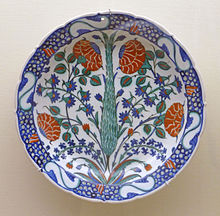
Back عجينة الحجر Arabic Frittenporzellan German Frittkeraamika Estonian Fritware ID Ceramica vitrea Italian ソフトペースト Japanese Фриттовый фарфор Russian Fritware Uzbek Đồ gốm frit Vietnamese



Fritware, also known as stone-paste, is a type of pottery in which ground glass (frit) is added to clay to reduce its fusion temperature. The mixture may include quartz or other siliceous material. An organic compound such as gum or glue may be added for binding. The resulting mixture can be fired at a lower temperature than clay alone. A glaze is then applied on the surface.
Fritware was invented to give a strong white body, which, combined with tin-glazing of the surface, allowed it to approximate the result of Chinese porcelain. Porcelain was not manufactured in the Islamic world until modern times, and most fine Islamic pottery was made of fritware. Frit was also a significant component in some early European porcelains.